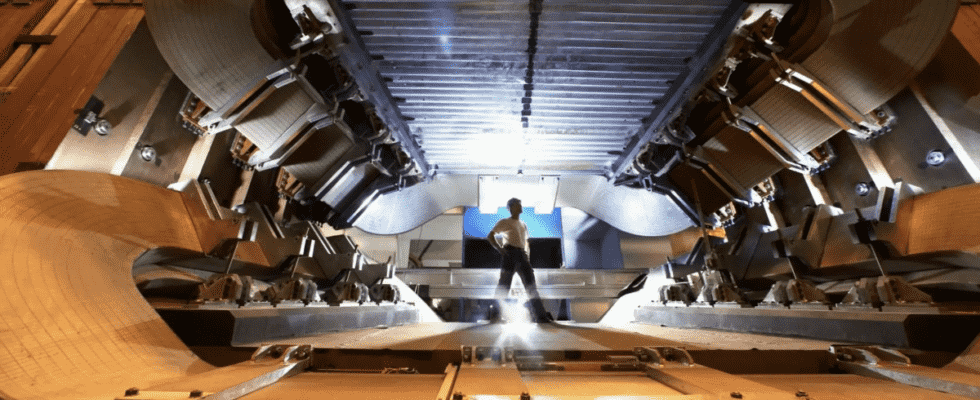The world’s largest research facility will soon be back in top form. The gigantic particle accelerator at the European Organization for Nuclear Research (CERN) in Geneva will be restarted from the end of March 2022 after a three-year maintenance break. From June, proton beams will again be chased against each other at practically the speed of light in the 27-kilometer underground ring in order to generate collisions. Physicists hope for groundbreaking new findings, as research director Joachim Mnich of the German press agency says.
Improved performance
The particle accelerator, completed in 2008, simulates the time shortly after the Big Bang, i.e. the birth of the universe around 14 billion years ago. The researchers search for the fundamental laws of the universe and investigate the smallest components of matter, the elementary particles. For this purpose, particles are brought to collision in order to observe the resulting decay processes. Among other things, in 2012 CERN succeeded for the first time in detecting the Higgs boson particle, theoretically described more than 40 years earlier, which gives other elementary particles their mass. It was considered the final piece of the puzzle in the Standard Model of particle physics.
In the course of the inventory, the performance of the accelerator and the connected detectors have been significantly improved. The number of collisions recorded should be twice as high as before. “We get access to processes that are very rare. The higher the number of collisions, the more accurate the results,” says Mnich.
There are two areas in which we can expect particularly exciting findings in the near future, explains Mnich, who, prior to his appointment at the beginning of the year, was Director of Particle and Astroparticle Physics at the German Electron Synchrotron (DESY) for a long time.
Clarify the possible existence of a new particle
In one of the research facilities, the LHCb, observations were made this year for the first time that deviate from the standard model of physics, which describes twelve matter particles and their interaction. The so-called beauty quarks did not decay into muons and electrons in equal parts, as expected. The cause of the effect could be a previously unknown force of nature, says Mnich. However, the observation must be made much more often in order to have security.
“We hope that we can clarify the question of whether this is real or a statistical mirage in the next two years. That would be a sensation. We would then have clear evidence for the first time that the Standard Model is not complete and not describes all phenomena. “
Understand how nature works
A new age is also beginning for antimatter experiments, says Mnich, “perhaps with surprises”. The “Elena” decelerator (Extra Low ENergy Antiproton ring), which went into operation in 2017, has been upgraded during the maintenance phase. In it, the anti-protons are slowed down so that they can be better captured and observed. “We are looking at the question: Does antimatter fall down like normal matter or does it fall up?”, Says Mnich. Gravitation is a very weak force at the level of the sub-atoms, so it is very time-consuming to prove it.
What does all this bring for people? “Of course it is always a gain in knowledge. We try to understand what holds the world together, how nature works,” says Mnich. Particle research has already brought a lot of concrete benefits. “It wasn’t clear at the time that the cell phone would develop from the discovery of how atoms work 100 years ago.” Among other things, the devices and processes developed at CERN are used in medicine, especially in cancer therapy and tumor control. Not to be forgotten is the Internet, for which the then CERN computer specialist Tim Berners-Lee created the basis with the World Wide Web in 1990.
Even bigger ring from 2040?
CERN has big plans: A leap for the particle accelerator will come in the second half of the decade, when the so-called HiLumi phase begins thanks to further expansions: Then it will produce five to ten times more proton collisions per second than it does today and thus generate even more Data that the scientists can evaluate. Until then, even stronger magnets have to be developed that focus the proton beams even more strongly at the collision points. “There are already prototypes, but not all quality criteria have been met,” says Mnich.
The concept for an even larger accelerator is on the table for the 1940s: a ring that is 100 kilometers instead of the previous 27 kilometers. The feasibility studies for this have been running since summer. With its current particle accelerator, CERN is a world leader, but there are also ambitious plans in Japan, and especially in China.
Champagne in the event of a collision
The next champagne bottles will now be frozen at CERN for June 2022. Then two months of the accelerator’s careful start-up should be completed. “It’s not like a car: turn the key and off you go,” says Mnich. The smallest mistakes could destroy devices worth millions. When the first collisions occur in June, this can be seen on the screens in the control room, when the physicists traditionally hand over champagne to the accelerator crew. “There are quite a number of bottles there,” says Mnich. Empty, of course.
(tiw)
